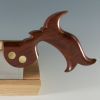
Originally Posted by
keith micinski

I'm not sure how half the people around here even bring themselves to do woodworking when all they do is try and identify every single safety hazard... Working safely is great but eliminating all safety hazards with a power tool is not possible. Recognizing them and using common sense to get a job done is.
Personally, I really value the emphasis on safe working at SMC. I think we "bring ourselves to do woodworking" because we try to avoid hazardous situations if at all possible - and share that to keep our mutual situational awareness a bit higher. I recently invested $200 in a Shark Guard after reading a lot about TS safety here - for a saw that never had a guard in the 15 years since I bought it. And just today I spent the afternoon making some new push sticks to keep my hands further from the blade - again, based on input received here. (Not everyone has a sawstop just yet.)
The OP can do whatever he wants with the input we provided, just like all of us do. If he feels safe doing the work, Im good with that. We're all big boys and girls. I think folks were trying to help.
Personally, I hope the community will continue to nudge me in the direction of being more aware of my safety.
Fred
Last edited by Frederick Skelly; 02-01-2015 at 6:35 PM.
"All that is necessary for the triumph of evil is that good men do nothing."
If you want to know what a man's like, take a good look at how he treats his inferiors, not his equals.





 Reply With Quote
Reply With Quote








